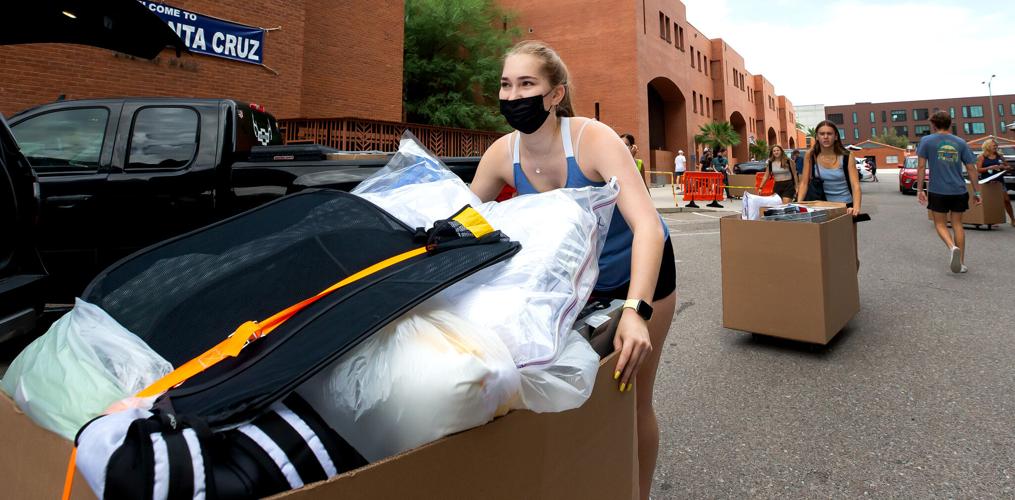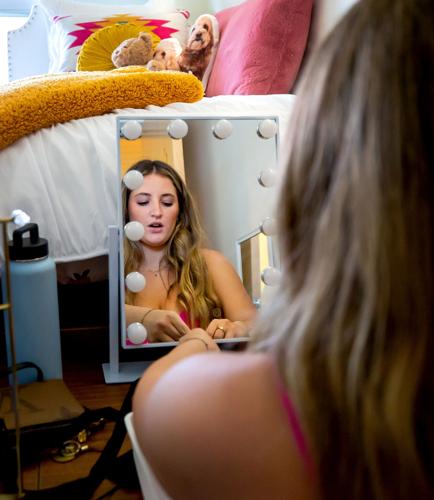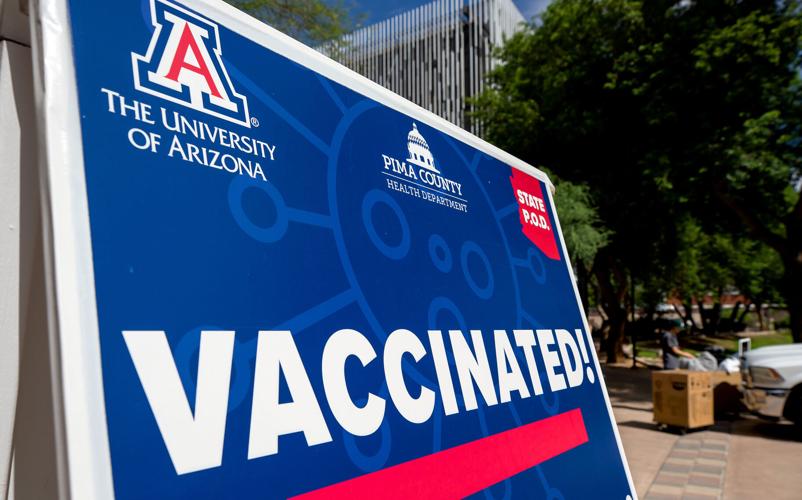Wiped-out shelves at Walmart usually mean one thing in late August in Tucson: Students have arrived en masse at the University of Arizona.
Starting Monday, more than 40,000 students will be moving through campus lecture halls, dormitories and neighborhood bars in a capacity not seen since the pandemic sent everyone home in March 2020.
It’s the second school year the UA is kicking off since then, but it’s the first time it’s restored the campus to majority in-person learning. Despite the numerous health and safety precautions the UA has in place, reopening the campus at full capacity — as the delta variant surges, vaccination rates stagnate and a state edict prevents required testing and vaccines — is stirring feelings of uncertainty among some students and faculty.
‘Threat of the delta variant’
“I’m not going to be making casual trips to campus. To me, it’s not worth it,” Nick Halsey, a senior lecturer in the English Department, said. He’s teaching online this semester, but does have some on-campus obligations, too. “Unfortunately, any of the excitement or positive feeling you get from the buzz of the campus is overshadowed by the threat of the delta variant.”
Last spring, as case counts declined and the general public gained widespread access to the COVID-19 vaccine, the UA was among hundreds of higher education institutions planning a fall semester marked by mostly in-person learning experiences.
“I am pleased to publicly announce today our intention to return to in-person classes at the University of Arizona for the fall semester,” UA President Robert Robbins said in a news release in April. “We will honor all local, state and federal protective measures that apply, and, of course, there are many factors that remain beyond our control. However, we are tackling what is within our control to ensure our students have the opportunity for a full on-campus experience.”
The backdrop of reopening a massive public university has changed since then.
In Pima County, COVID-19 cases increased more than four times between the first week of July and the first week of August, according to data from the Arizona Department of Health Services. Around 95% of all new cases in Arizona are found in people who have not been fully vaccinated, which is a little over half of the state’s population.
The surge is taking a toll on the local health-care system. As of Wednesday, there were only 11 ICU beds left in the county and on Thursday, the county recorded 401 new cases and is now in the “high” COVID-19 transmission category.
UA, however, has remained committed to providing its student body, which this year includes the largest incoming class of first-year students (more than 8,700 students) ever, access to that “full on-campus experience” Robbins pledged last spring.
In preparation, the university has installed thousands of air filters on campus, continued its innovative groundwater testing program, and both incentivized and urged students and staff to get vaccinated, among other measures. And as panic over the delta variant’s grip on Arizona earlier this month, the UA joined Arizona State University and Northern Arizona University in seizing a loophole in Gov. Doug Ducey’s ban on requiring unvaccinated students to wear masks.
All three universities have since implemented a rule that says masks must be worn by everyone, regardless of vaccination status, in indoor spaces where social distancing is not possible, including classrooms and dormitories. There are signs all over campus reminding students to “Bear Down Mask Up,” and students who don’t comply could be subject to disciplinary action.
“It makes me feel more comfortable, especially because not everyone is vaccinated,” said Michelle Wong, a pre-business major from Glendale whose parents helped her move into the Villa del Puente Dorm on Wednesday morning.
She’s one of 7,370 students living on campus this year, but state law prevents the UA from knowing exactly how many of those students — or the thousands more living off campus — are vaccinated. According to UA, as of last week 51% of employees and 47% of main campus students had uploaded their vaccination cards, though those numbers are different from actual vaccinations.
Reducing exposure to potentially unvaccinated peers is part of the reason why Wong signed up to take half of her classes online. The other half of it, she said, was because some of the in-person courses were already full by the time she was able to register. Although attending her senior year of high school online prepared her for the mechanics of online learning, the thought of UA going fully remote to contain the pandemic is “stressful” nonetheless.
“I am a little bit worried because I really want that full college experience,” Wong said. “I hope I’d still be able to make friends if we did go back online.”
“Flexibility is important”
According to the registrar’s office, about 63% of all courses this semester will be delivered entirely in person and 9% through a hybrid of in-person and remote modalities. (In fall 2020, only about 12% of classes were delivered entirely in person and 31% were hybrid.) According to a memo Provost and Senior Vice President for Academic Affairs Liesl Folks sent to faculty a little over a week ago, that breakdown isn’t designed to be easy to change at this point.
“Instruction must be delivered in the modality students selected when they signed up for classes. Individual faculty members are not permitted to change the delivery mode of their class,” reads the memo, which also reminded faculty that any requests to move a class online will need final approval from the provost’s office.
“However, the university is continuing to monitor public-health conditions in our community and may issue modified guidance as the semester progresses,” Folks told the Arizona Daily Star, noting that the UA gives high priority to finding accommodations for instructors with disabilities or health concerns. “Decisions regarding course modalities will be made on a universitywide basis by university leadership in consultation with public-health officials.”
Offering “safer alternative forms of learning, teaching, and working to students, faculty and staff who do not feel comfortable returning to in-person learning and working,” was one of the considerations UA’s chapter of the United Campus Workers of Arizona asked university leadership for earlier this month, along with hazard pay, required testing and mask and vaccine mandates, though state law has tied the university’s hands on any vaccination or testing requirements.
“Flexibility is important. People are in different living situations and that’s true for students, staff and faculty,” said Gary Rhoades, a tenured professor of higher education and member of the local UCWA. He polled his students to find out how they’d prefer to take their courses, and has decided on offering it in a hybrid format to accommodate their preferences.
But Rhoades said from what he’s heard, that kind of flexibility doesn’t seem to apply to all of his colleagues, especially those who don’t hold permanent positions, which is about half of all faculty members employed at the UA. “The challenge is that if you’re not on the tenure-track and you don’t have job security, that pressure to (teach in-person) is a lot harder to resist than it is for someone like me who’s been here for 35 years.”
He’s also skeptical of the UA’s motivations for pushing in-person learning and activities this year.
“The problem is that when administrators say this they have a particular idea of a student in mind. They’re thinking of an 18-, 19- or 20-year-old who’s perfectly healthy, who lives on campus and who has a lot of money,” said Rhoades. “We’ve got a lot of students who are working in the community. We’ve got students who are living off campus with their families in multi-generational households.”
“Who’s vaccinated and who’s not?”
Those are some of the things Zahraa Humadi, a junior majoring in information technology, has been thinking about ahead of this semester. She lives at home with her parents to save money and is looking forward to returning to campus after 18 months of limited social interactions and isolating online classes.
“There was a moment where I was like I’ll be fine. I thought everything had calmed down,” she said. “But with these new variants, it’s a lot scarier than it was a few months ago. There are states with no or few hospital beds. Now, I don’t think it’s calmed down at all. People have just stopped caring.”
Although she’s been fully vaccinated since April, Humadi, who got a job at a dining hall on campus after finding out her unemployment benefits were expiring, is only taking two of five classes in person. “I’m happy I have some of my classes online just so I don’t have to be in big lecture halls 24/7 because I don’t know if everyone’s been vaccinated.”
Humadi doesn’t want to risk bringing the virus back to her parents’ home, and said it’s frustrating the UA can’t require vaccinations. “I hate that there’s this uncertainty about who’s vaccinated and who’s not,” she said. “I don’t want to sit next to some guy who’s fully capable of being vaccinated and he’s just not for the sake of it. It’s not fair to the rest of us.”
In her view, if the UA campus does have to shut down in-person operations again, it wouldn’t be the worst case scenario.
“I would miss my social life,” Humadi said. “But I’d rather everyone be safe instead of having lives on the line for the sake of brunch.”
University of Arizona students are returning to the Tucson campus and filling up dorms just in time for the fall semester, which begins Monday, Aug. 23.





